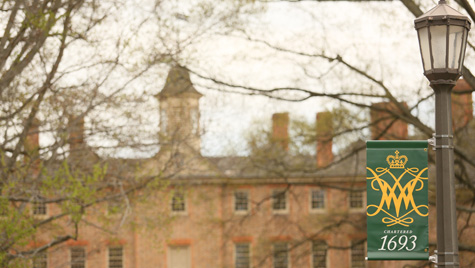W&M Board endorses six-year plan
Editor's note: The W&M Board of Visitors unanimously voted May 12, 2020, to roll back a previously adopted tuition increase for incoming in-state undergraduates and keep tuition and mandatory fees flat for all students, including in-state and out-of-state undergraduates, graduate and professional students. According to the budget resolution, the tuition and fee rates adopted by the Board are for the upcoming 2020-21 academic year. It reverses action taken by the Board in the fall, which included for a 3% tuition increase for new in-state undergraduates, in accordance with the university’s six-year plan. That plan, which was adopted in September, called for in-state undergraduate tuition increases of up to 3% each year. Going forward, the intent is that the Board will revisit future tuition recommendations in advance of the 2021-22 academic year.
Modified tuition model, tuition predictability and strategic initiatives highlight plan
Current in-state students will continue to see no increase in tuition
The William & Mary Board of Visitors on Friday unanimously endorsed the university’s six-year plan, which includes a modified tuition model beginning in fall 2020 that is designed to reduce the rate of growth in tuition, maintain predictability and simplify the planning process for Virginia families.
The Commonwealth requires all Virginia public higher education institutions to submit a six-year plan each biennium with annual updates if needed. The plan, which must be submitted to the state by Oct. 1, outlines several key assumptions at William & Mary moving forward:
- Reducing over time the anticipated cost increases for in-state undergraduates by modifying the existing tuition guarantee. W&M will limit in-state undergraduate tuition increases for incoming students to no more than 3% and guarantee that year-over-year increases will be no more than 3% annually.
- Incremental enrollment growth.
- Continued commitment to increase in-state undergraduate, need-based aid to ensure accessibility for Virginia’s low- and middle-income families.
- Merit-based increases in faculty and staff salaries to remain competitive nationally.
- Incremental funding for strategic initiatives, including increased graduate student stipends; expansion of the Studio for Teaching & Learning Innovation; new student internship opportunities; the launch of a master’s degree program in computer science; investments in information technology; and enhanced programs to support regional entrepreneurship.
The plan outlines modifications to the William & Mary Promise, the university’s tuition model adopted in 2013, said Sam Jones, senior vice president for finance and administration, that will maintain predictability but enhance affordability. For future entering classes of in-state students, W&M will limit the tuition increases for in-state undergraduates to no more than 3% and then guarantee going forward that price will increase by no more than 3% per year. Currently, the university resets tuition for each entering class – historically at a higher rate than 3% – and guarantees that rate for four years. Going forward, the university plans to slow the rate of tuition increases for each entering in-state class, Jones said. The change begins with next fall’s entering Class of 2024. Continuing in-state undergraduate students here under the W&M Promise will continue to see no increase in tuition.
“This next iteration of the William & Mary Promise allows the university to preserve in-state access and enhance affordability for low- and middle-income students, while providing a predictable tuition cost guarantee for all in-state students,” said President Katherine A. Rowe. “It also allows the university to be a partner in enabling the Commonwealth to attract and retain the talent needed to grow Virginia’s economy.”
Since 2013, William & Mary has increased undergraduate financial aid by 132 percent and has reduced the “net price” for low- and middle-income Virginians with need. According to the most recent data by the U.S. Department of Education, W&M is the least expensive public university in Virginia, on an average net-price basis, for in-state families at income levels less than $110,000. The university is currently the fourth lowest on a net-price basis across all income levels. W&M’s fiscal year 2020 budget for financial aid currently totals $53.6 million in combined support from the state, incremental tuition revenue and private funds. Of the total $53.6 million budgeted for financial aid this year, $44.3 million is allocated to support undergraduate students.
The six-year plan also includes requests for additional state general fund support in the 2020-2022 biennium, including continued expansion of the university’s new data science major; matching funds for the expansion of student internships; operation and maintenance support for new facilities; and a pilot Faculty Industry-Partner Fellows program. The Fellows program would embed five faculty the first year and up to 10 in subsequent years in industries throughout the Commonwealth.
“We hope this pilot program serves as a model for how higher education, government and business can work together in new ways,” said Provost Peggy Agouris. “Industry partners will provide faculty real-world experiences they can bring back to their students. Business partners will benefit from having in-house faculty expertise in areas of strategic importance.”
The six-year plan is separate from the university’s Tech Talent Pipeline proposal, Jones said. He added the state asked universities to exclude their Tech Talent Pipeline proposal from their six-year plans and that the two documents will be reviewed separately. In support of William & Mary’s proposal, last spring the Board adopted a resolution endorsing the university’s plan to increase the number of undergraduate computer science degrees from 70 to at least 160 per year. The resolution also states the university will establish a new professional master’s degree in computer science and grow W&M’s new data science major to at least 40 degrees per year.
The Board will adopt next year’s in-state tuition rates at its November meeting. Out-of-state tuition, as well as all fees, room and board costs, will be approved at the Board’s regular meeting in April.
 Skip to main content
Skip to main content

